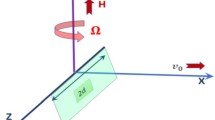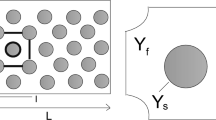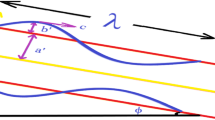Abstract
An analysis is presented to investigate the effects of radiative heat transfer on entropy generation in flow of two immiscible non-Newtonian fluids between two horizontal parallel plates. Both the plates are maintained at constant temperatures higher than that of the fluid. The Stokes’ couple stress flow model is employed. The flow region consists of two zones with the flow of the heavier fluid taking place in the lower zone. The classical “no-slip” condition is prescribed at the plates and continuity of velocity, vorticity, shear stress, couple stress, temperature and heat flux are imposed at the interface. The original partial differential Navier–Stokes equations are converted to ordinary differential equations by assuming velocity and temperature are functions of vertical distance and solved mathematically by usual classical methods. The derived velocity and temperature profiles are used to compute the expressions for the entropy generation number and Bejan number. The effects of relevant parameters on velocity, temperature, entropy generation number and Bejan number are investigated. The computations show that the entropy production decreases with thermal radiation, whereas it increases with viscous dissipation. The effect of viscous dissipation is justified since it significantly affects heat transfer and entropy generation characteristics and therefore should not be ignored.

















Similar content being viewed by others
Abbreviations
- Be :
-
Bejan number
- Br :
-
Brinkman number
- (Br/Ω):
-
Viscous dissipation parameter
- E :
-
Specific internal energy
- Ek :
-
Eckert number
- \( \overline{f} \) :
-
Body forces per unit mass
- 2h :
-
Height of the free channel
- \( {\bar{\mathbf{h}}} \) :
-
Heat flux
- k 1, k 2 :
-
Thermal conductivity of the fluid in zone-I, II
- \( \overline{\ell } \) :
-
Body couple per unit mass
- n η :
-
Couple stress coefficients ratio
- n k :
-
Thermal conductivity ratio
- n μ :
-
Viscosity ratio
- n ρ :
-
Density ratio
- \( Nf_{i} \) :
-
Entropy generation due to viscous dissipation
- \( Ns_{i} \) :
-
Dimensionless total entropy generation number
- \( Ny_{i} \) :
-
Entropy generation due to transverse conduction
- \( Nu \) :
-
Nusselt number
- q r :
-
Radiation heat flux
- Pr :
-
Prandtl number
- \( \bar{q} \) :
-
Velocity vector
- N R :
-
Radiation parameter
- P :
-
Pressure
- Re :
-
Reynolds number
- s 1, s 2 :
-
Couple stress parameters
- \( \left( {S_{i} } \right)_{\text{G}} \) :
-
Entropy generation rate
- \( \left( {S_{1} } \right)_{{{\text{G}},{\text{C}}}} \) :
-
Characteristic entropy transfer rate
- T 1, T 2 :
-
Non-dimensional temperatures
- u :
-
Non-dimensional velocity in X-direction
- x, y :
-
Non-dimensional space coordinates
- X, Y :
-
Space co-ordinates
- μ 1, μ 2 :
-
Viscosity coefficients
- η, η′:
-
Couple stress viscosity coefficients
- \( \bar{\omega } \) :
-
Rotation of the fluid particle
- Ω :
-
Dimensionless temperature difference
- Φ :
-
Dissipation function
- ϕ :
-
Irreversibility distribution ratio
- ρ :
-
Density
- θ :
-
Non-dimensional temperature
- 1:
-
Fluid in zone I
- 2:
-
Fluid in zone II
References
Arpaci VS (1986) Radiative entropy production. AIAA J 24(11):1859–1860
Arpaci VS (1987) Radiative entropy production—lost heat into entropy. Int J Heat Mass Transf 30:2115–2123
Arpaci VS (1991) Radiative entropy production—heat lost to entropy. Adv Heat Transf 21:239–276
Arpaci VS, Selamet A (1986) Radiative entropy production. In: Tien CL, Carey VP, Ferrell JK (eds) Proceedings of 8th international heat transfer conference, San Francisco, California, vol 2, pp 729–734
Selamet A, Arpaci VS (1990) Entropy production in boundary layers. AIAA J Thermophys Heat Transf 4:404–407
Chen Chao-Kuang, Yang Yue-Tzu, Chang Kuei-Hao (2011) Entropy generation of radiation effect on laminar-mixed convection along a wavy surface. Heat Mass Transf 47:385–395
Bataller RC (2008) Radiation effects in the Blasius flow. Appl Math Comput 198:333–338
Bejan A (1979) A study of entropy generation in fundamental convective heat transfer. ASME J Heat Transf 101:718–725
Bejan A (1980) Second law analysis in heat transfer. Energy 5:721–732
Hooman K (2005) Second law analysis of thermally developing forced convection in a porous medium. Heat Transf Res 36(6):437–448
Hacen D, Slimi K, Nasrallah SB (2008) Entropy generation for pulsating flow in a composite fluid/porous system. J Porous Media 11(6):557–574
Khan WA, Gorla RSR (2010) Second law analysis for mixed convection in non-Newtonian fluids over a horizontal plate embedded in a porous medium. Spec Top Rev Porous Media 1(4):353–359
Bird RB, Stewart WE, Lightfoot EN (1960) Transport phenomena. Wiley, New York
Kapur JN, Shukla JB (1964) On the unsteady flow of two incompressible immiscible fluids between two plates. J Appl Math Mech 44(6):268–269
Bhattacharya RN (1968) The flow of immiscible fluids between rigid plates with a time dependent pressure gradient. Bull Calcutta Math Soc 1:129–137
Chaturani P, Samy RP (1985) A study of non-Newtonian aspects of blood flow through stenosed arteries and its applications in arterial diseases. Biorheology 22(6):521–531
Rao AR, Usha S (1995) Peristaltic transport of two immiscible viscous fluids in a circular tube. J Fluid Mech 298:271–285
Bakhtiyarov SI, Siginer DA (1997) A note on the laminar core-annular flow of two immiscible fluids in a horizontal tube. In: International symposium on liquid–liquid two phase flow and transport phenomena, Santa Barbara, California, USA, pp 107–111
Chamkha AJ (2004) Oscillatory flow and heat transfer in two immiscible viscous fluids. Int J Fluid Mech Res 31:13–36
Kamisli F, Oztop HF (2008) Second law analysis of the 2D laminar flow of two-immiscible, incompressible viscous fluids in a channel. Heat Mass Transf 44:751–761
Stokes VK (1966) Couple stresses in fluid. Phys Fluids 9(9):1709–1715
Stokes VK (1984) Theories of fluids with microstructure. Springer, New York
Naduvinamani NB, Hiremath PS, Gurubasavaraj G (2001) Squeeze film lubrication of a short porous journal bearing with couple stress fluids. Tribol Int J 34:739–747
Naduvinamani NB, Hiremath PS, Gurubasavaraj G (2002) Surface roughness effects in a short porous journal bearing with couple stress fluid. Fluid Dyn Res 31:333–354
Naduvinamani NB, Fathima ST, Hiremath PS (2003) Effects of surface roughness on characteristics of couple stress squeeze film between anisotropic porous rectangular plates. Fluid Dyn Res 32:217–231
Brewster MQ (1992) Thermal radiative transfer and properties. Wiley, New York
Butt AS, Munawar S, Ali A, Mehmood A (2012) Entropy generation in the Blasius flow under thermal radiation. Phys Scr 85(3):035008
Paoletti S, Rispoli F, Sciubba E (1989) Calculation exergetic loses in compact heat exchanger passages. ASME AES 10:21–29
Adesanya SO, Makinde OD (2015) Effects of couple stresses on entropy generation rate in a porous channel with convective heating. Comput Appl Math 34:293–307
Aïboud S, Saouli S (2010) Entropy analysis for viscoelastic magneto hydrodynamic flow over a stretching surface. Int J Non-Linear Mech 45(5):482–489
Rashidi MM, Parsa AB, Bég OA, Shamekhi L, Sadri SM, Bég TA (2014) Parametric analysis of entropy generation in magneto-hemodynamic flow in a semi-porous channel with OHAM and DTM. Appl Bion Biomech 11:47–60
Author information
Authors and Affiliations
Corresponding author
Additional information
Technical Editor: Francis H. R. Franca.
Rights and permissions
About this article
Cite this article
Srinivas, J., Murthy, J.V.R. & Bég, O.A. Entropy generation analysis of radiative heat transfer effects on channel flow of two immiscible couple stress fluids. J Braz. Soc. Mech. Sci. Eng. 39, 2191–2202 (2017). https://doi.org/10.1007/s40430-017-0752-6
Received:
Accepted:
Published:
Issue Date:
DOI: https://doi.org/10.1007/s40430-017-0752-6




